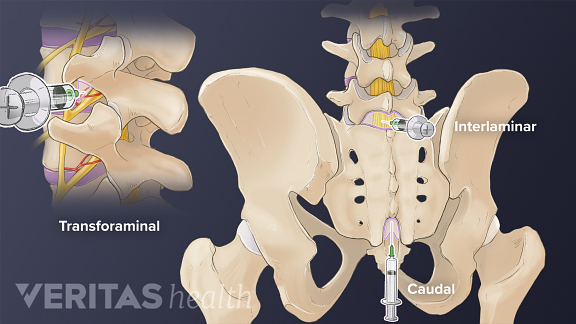
Epidural steroid injections (ESIs) are a common treatment option for many forms of lower back pain and leg pain. They have been used for decades and are considered an integral part of the nonsurgical management of sciatica and lower back pain.
The injection is named an epidural steroid injection because it involves injecting a local anesthetic and a steroid medication directly into the epidural space that surrounds the spinal cord and nerve roots.

The goals of an epidural steroid injection are to:
Sinir köklerinin içindeki ve çevresindeki iltihabı azaltarak ağrıyı kontrol edin
Alt sırt ve bacaklarda hareketliliği ve işlevi geliştirin
Hastanın kapsamlı bir fizik tedavi ve rehabilitasyon programına katılmasına ve ilerleme kaydetmesine izin verin
Bir kişinin bakım programı sırasında, çoğu durumda, ilaçlar ve fizik tedavi gibi bir dizi cerrahi olmayan tedavi denendikten sonra ve ameliyat düşünülmeden önce epidural steroid enjeksiyonu önerilebilir.
The role of the injection is typically to provide sufficient pain relief to allow a return to everyday activities and to make progress in physical therapy.
This article includes extensive research and information about how epidural injections may be used to treat lower back problems and sciatica.
Most practitioners will agree that an epidural injection can be beneficial during an acute episode of back and/or leg pain. The main drawbacks of the injections are that they are not always effective, and when effective, the pain relief tends to be temporary, ranging from one week to one year. Typically, if the initial injection is effective, up to 3 injections may be given in one year.
When administered in the lumbar epidural space, steroid injections may have the following benefits:
Sinir ağrısını ve iltihabı azaltın. Steroidler, enflamatuar kimyasalların üretimini azaltır ve sinir liflerinin ağrıya duyarlılığını azaltarak daha az ağrı sinyali üretir.3,4
Ağızdan alınan ilaçları sınırlayın. Bu enjeksiyonlardan kaynaklanan ağrının giderilmesi, bazıları uzun süreli alındığında yan etkileri olabilen oral ilaçlara4 duyulan ihtiyacı sınırlamaya veya ortadan kaldırmaya yardımcı olabilir.
Fizik tedaviye devam edin veya yeniden başlayın. Bu enjeksiyon, hastanın iyileştirici bir fizik tedavi programı ile ilerlemesine izin vermek için yeterli ağrı kesici sağlayabilir.1
Ameliyatı erteleyin. Lomber epidural steroid enjeksiyonlarından kaynaklanan ağrı kesici, ameliyatın ertelenmesine yardımcı olabilir ve fizik tedavi etkili ise cerrahi müdahale ihtiyacını ortadan kaldırabilir.4,5
Altta yatan duruma, hastanın ihtiyaçlarına ve doktorun tercihine ve deneyimine bağlı olarak epidural enjeksiyon uygulamak için çeşitli teknikler kullanılabilir.

A doctor may choose the route of administration depending on their experience and skill, the use of guided fluoroscopy, the patient’s diagnosis, and the results from previous treatments for similar symptoms and diagnoses.
Available research indicates generally favorable results, with 70% to 90% of patients experiencing pain relief from these injections, lasting for a week to a year. If a good first response is seen, a second injection may be considered when the improvement from the first injection begins to taper off. Typically, up to 3 injections may be given over a 12-month period.
While many studies have documented the short-term benefits of epidural steroid injections, the data on long-term effectiveness are less convincing. Controversy persists regarding their effectiveness in reducing pain and improving the function. Literature both supporting and opposing them are available.
In addition, there are several limitations in the research that has been conducted, such as:
These methodological flaws tend to limit the usefulness of the research. More studies are needed to define the role of epidural steroid injections in lower back pain and sciatica.
Lumbar epidural injections are typically used in the treatment of conditions that cause irritation and/or inflammation of spinal nerve roots with associated lower back and leg pain. Most common lower back conditions treated include1: 1 :
Less commonly, localized back pain (axial back pain) and neurogenic claudication (back pain and leg pain that occurs while walking) may be treated with these injections.
Doctors who administer this type of injection include spine and pain management specialists, such as physiatrists, anesthesiologists, radiologists, neurologists, and spine surgeons. The injection procedure typically takes place in a surgery center, hospital, or a physician’s clinic.
Epidural steroid injections are considered a relatively safe and minimally invasive. Temporary side effects may occur in some cases and include (but are not limited to):
These side effects typically resolve in a few minutes to hours. Serious complications, while rare, may include spinal cord damage, dural puncture, and/or stroke.
In general, epidural injections administered for spinal levels L4 or lower carry a lesser risk of complication(s) compared to higher levels.The injections are typically performed under fluoroscopy (x-ray guidance) with a contrast dye. Fluoroscopy helps guide the needle to the accurate location and helps prevent nerve and/or artery damage.
The injections are typically not given when certain complicating medical conditions are present, such as infections, tumors, or bleeding disorders. Additionally, the injections may not be given in case of uncontrolled diabetes mellitus, certain heart conditions, and pregnancy
If necessary, a relaxation medication may be given through an intravenous (IV) line in the patient’s arm, but the patient is usually conscious during this procedure. The treatment area in the lower back is numbed with a local anesthetic injection before the epidural is given, so the epidural injection procedure is usually painless.
An epidural steroid injection procedure may take about 30 minutes to administer. A tingling or mild burning sensation, or the feeling of pressure may be experienced as the medication enters the epidural space. When the injection is completed, the irritation and discomfort usually disappear within a few minutes. Patients typically return home after a few hours. Specific post-injection precautions are followed over the next few days.
Find us on map
Send us an email
Call: +90 (530) 915 69 68